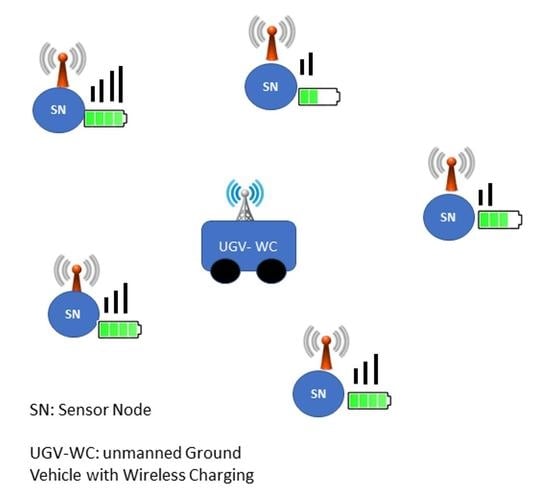Radio Frequency Based Wireless Charging for Unsupervised Clustered WSN: System Implementation and Experimental Evaluation
Abstract
:1. Introduction
- This paper continues and expands our previous work on WC implementation and experimentation [15] such that it provides technical and practical insights, experimental verification, and evaluation of this technology using off-the-shelf (commercially available) products, thus making the results of this paper easily repeatable by others and facilitating the adoption of this technology in real applications;
- Provide a theoretical study on how to estimate the received power in wireless charging taking into consideration the distance between the wireless charging station and the target node, thus identifying the proper wireless energy propagation model. Identifying the proper wireless channel model is important in order to better estimate the amount of the received energy thus estimating the charging time and duration. Furthermore, the attained experimental results are compared with the theoretical results to demonstrate a close match that exists between the two results;
- The provided theoretical and experimental results assist the researchers and technology adopters to understand the technology, identify its capabilities and limitations while considering it for various applications such as WSN and the IoT;
- The paper introduces a use case for WC in the context of WSN, where the idea of utilizing the CH as a charging node for an unsupervised clustered WSN is proposed. Such a proposition is important due to the CH central location among the other nodes and its prime role in communicating with the other nodes, thus making it the best candidate for providing WC functionality to the sensor nodes.
2. Literature Review
3. Technical Background
Wireless Charging Implementation Circuit
- Transmitter (TX91501-3W-ID): The transmitter shown in Figure 2a uses the spread spectrum technique to send energy at a frequency of 915 MHz in the Industrial, Scientific, and Medical (ISM) band. The power transmitted is modulated using Direct Sequence Spread spectrum (DSS) which gives the advantage of less interference as we are sending the narrow band on a wider band, which in turn decreases the noise interference. It can move along with the power broadcast, transmit data, which is Amplitude Shift Keying (ASK)-modulated, and sends an 8-bit ID at random intervals at a frequency of 2.4 GHz. There are two different transmitters, one is able to send 1W Equivalent Isotopically Radiated Power (EIRP) and the other one can send 3W EIRP. In this paper, we used the 3W transmitter, which is supported by the utilized kit [14]. EIRP is the maximum power that is radiated from the transmitter in the direction where the antenna exhibits maximum gain in relation to the isotropic antenna. The antenna integrated in the transmitter has a gain of 8 dBi and is 60 degrees beam patterned, and vertically polarized. The transmitter can provide energy for unlimited harvesters;
- Wireless sensor board (WSN-EVAL-01): This board, which is shown in Figure 2d is able to sense humidity, light, temperature. Furthermore, it gives the option for user to add another sensor-measuring device, which can be connected to the external sensor board found on a terminal block (J3) if needed. The external sensor jack can only supply 3 Volts. The sensor board also has the ability of measuring the Received Signal Strength Indicator (RSSI) of the received power. The sensor information along with the RSSI measurement and node ID of the transmitter that is captured are sent as a packet via a Microchip MiWi P2P low power protocol [34]. The transmission is conducted using a frequency signal centered at 2.4 GHz to the Microchip access point together with the sensor ID that a user can set using the ID selection bits on the sensor board. This information can be viewed on a computer using the hyper terminal utility. The sensor board can be powered using the harvester board if attached on top of the breadboard connection on the harvester board. It has a PIC kit programming header that is used to program the PIC MCU on the sensor board;
- Harvester receiver P2110 evaluation board (P2110-EVB): There is an SMA connecter on the harvester board as shown in Figure 2c where the receiving antenna is connected and matched to 50 . As depicted in Figure 3, the receiver board has a P2110 harvester circuit which consists of an RF-DC converter that is implemented using the Microchip pcc110 chip and a voltage booster using the Microchip pcc210 chip. There is also a VCAP pin that can be connected to an external capacitor of the users’ choice or to the capacitors that are already available (C3 of 10mF or C5 of 50 mF). Furthermore, the user can adjust the S2 switch available on the board to either operate the sensor board or use the harvested power to light an LED, which can be easily seen as the LED blinks, or to indicate the arrival of a packet at the access point. As depicted on Figure 3, after the RF signal is received via the antenna and fed to the harvestor RFIN terminal, it is converted to a DC signal via the RF to DC converter circuit, which thereafter can be either stored in the capacitor connected to the pin VCAP (e.g., C3). Obviously, a smaller capacitor will charge much faster than a larger one but can provide power only for a shorter period. Furthermore, when the voltage signal reaches to a threshold value of V, the booster circuit generates an output pulse signal around V. However, this value can be increased or decreased by attaching an external resistor to the terminal VSET and to the ground as described in the circuit data sheet [35];
- Dipole and Patch Antennas: Figure 2g shows a dipole antenna with a 360-degree reception range, where as a patch antenna shown in Figure 2f has a 120-degree reception range. Both antennas operate at 915 MHz ISM frequency band. Furthermore, in order to obtain optimal reception, the antennas lengths are designed to have at least half of the utilized wavelength, which equals to 32.76 cm, and normalized 50 impedance. The patch antenna is able to receive more power as it has a gain of 6 dBi, as compared to the dipole antenna that has a gain of 1 dBi.
- Access point (WSN-AP-01): The Access point in Figure 2b has a USB connection that can be connected to a personal computer (PC) to display the information of the received packets, as well as, the amount of the received power. It also has the capability to receive information from 8 sensor boards. It receives the packets at a frequency of 2.4 GHz that is similar to the one used for radio modules, and displays the information on the PC. It maintains a counter for each of the sensor boards to record the total number of packets received by each sensor board;
- PICkit 3 programmable debugger (PG164130): The PICKit shown in Figure 2e is used to program the MCU on the sensor board or the access point. The user can update the PICkit tail attached to it and with the help of MPLAB IDE program, the microchip code.
4. Experiment Setup and Results
4.1. Experimental Evaluation
4.2. Measuring the Height and Width of the Pulse for Various Loads
- As shown in Figure 6 and Figure 7a, when the resistance used is increased, the width of the pulse kept increasing. As seen in Figure 6, there has been an increase from 99.25 ms to 212 ms and to 2.955 s. In this figure, we can also observe that as the pulse is generated, the capacitor voltage (colored in yellow) decreases slowly but the decrease is no more than 0.2 V. Then, the capacitor recharges back again and generates a new pulse. Furthermore, we observed that the time between the pulses remains unchanged when the loads were changed by considering a specific distance (in this case 6 m);
- As shown in Figure 6a, due to the small Ohmic value of the load, a small amount of power is being used up by the load, and that is the reason for not attaining the maximum voltage, and also, the discharge is noticed to be very minimal. On the other hand, higher voltage values were obtained due to the increased Ohmic value of the load, as can be seen in Figure 6b,c;
- The current values versus the load can also be found by either using Ohms law or by measuring it using a current meter, as it is easier to view the current when the width of the pulse increases. Figure 6a,b have been provided as a general case for both antennas considering all the distances from 0.6 to 12 m. It can be noticed from the figures that the charging process exhibits same behavior for all resistance values. However, when the distance increases, the time taken to reach the threshold voltage increases as shown in Figure 8;
- Furthermore, as depicted in Figure 7b. at the beginning, the power source was able to provide as much voltage as the load required and consequently, the current increased. For , the power source could no longer provide more voltage, thus the voltage remains constant and the current in the load starts to decrease, since , therefore, if V remained constant, and R is increased, then I should decrease. To better understand this phenomena, let us recall the relationship between the charging time needed to charge the capacitor C, and the load resistance R which states that . Based on this relationship, higher resistance will increase the time taken for the capacitor to charge because of the higher RC time constant. Therefore, the output voltage keeps on increasing until it reaches V which is the default maximum voltage for the built-in booster circuit. However, we can suitably adjust the RC constant by adding resistors in order to increase or decrease ;
- A linear relationship is seen in Figure 7a between the pulse width and the load value. As the load connected to increases, the pulse width of increases proportionately. This is because the duration depends on the capacitor discharge period. As the discharge time is directly proportional to the product of R and C, (i.e., ), an increase in R will directly increase . Furthermore, to quantify the measured values, for 1000 load, the width of the pulse is about s. For 6000 load, the width of the pulse is 4 s, and with this information, we can approximate any load’s pulse width () with the load value R by using the following equation: , where is the slope of the linear line between and R.
4.3. Measuring the Maximum Average Output Power
4.4. The Relationship between the Recharge Time and Distance
4.5. Measuring the First Charging Time
4.6. Charging 1 F Super Capacitor
5. Practical Challenges and Best Practices
- As explained in Section 3, it is important to determine the suitable path loss model that can be used to estimate the theoretical results for the harvested power, thus being able to predict precisely the amount of harvested energy. This step of utmost importance for charging the nodes in WSN network that can result in improvement in the lifetime of the network;
- It is advised to follow Electrostatic Discharge (ESD) precautions during the use of the kit, as it is prone to damage from static charges produced by the body. We have used anti-static wrist strap and anti-static mat during the experiments. The devices were not placed on top of the mat while taking measurements as it did affect the readings, yet there is a need to discharge whenever one moves and carries the devices;
- The kit is sensitive and influenced by the environment too, as any obstacle on the way can affect the radio wave propagation. Furthermore, since the utilized frequency is 915 MHz, it may be interfered by other devices such as mobile phones operating in the same frequency. Thus, several measurements have to be recorded and averaged to get accurate values, which is a time consuming process;
- Another challenge we encountered was in measuring the current, especially for short distances using the multi-meter. It was not easy as the frequency of the pulsating voltage is high and the width of the pulse is very small.
6. WSN Wireless Charging-Use Case
7. Conclusions and Future Work
Author Contributions
Funding
Institutional Review Board Statement
Informed Consent Statement
Data Availability Statement
Acknowledgments
Conflicts of Interest
References
- Del-Valle-Soto, C.; Velázquez, R.; Valdivia, L.J.; Giannoccaro, N.I.; Visconti, P. An Energy Model Using Sleeping Algorithms for Wireless Sensor Networks under Proactive and Reactive Protocols: A Performance Evaluation. Energies 2020, 13, 3024. [Google Scholar] [CrossRef]
- Sakkijha, Z.; Qaderi, H.; Ghatasheh, O.; Issa, A.; Shatat, A.; Jaber, H.; Alwardat, R.; Alhaj-Ali, S. An Energy Efficient WSN Implementation for Monitoring and Critical Event Detection. In Proceedings of the 2019 2nd IEEE Middle East and North Africa COMMunications Conference (MENACOMM), Manama, Bahrain, 19–21 November 2019; pp. 1–6. [Google Scholar]
- Khalifeh, A.; Bartolini, N.; Silvestri, S.; Bongiovanni, G.; Al-Assaf, A.; Alwardat, R.; Alhaj-Ali, S. Hybrid wireless sensor networks: A prototype. In Proceedings of the IFIP Conference on Human-Computer Interaction, Bombay, India, 14–18 September 2019; pp. 549–553. [Google Scholar]
- Darabkh, K.A.; Wafa’a, K.K.; Ala’F, K. LiM-AHP-GC: Life Time Maximizing based on Analytical Hierarchal Process and Genetic Clustering protocol for the Internet of Things environment. Comput. Netw. 2020, 176, 107257. [Google Scholar] [CrossRef]
- Del-Valle-Soto, C.; Mex-Perera, C.; Nolazco-Flores, J.A.; Velázquez, R.; Rossa-Sierra, A. Wireless Sensor Network Energy Model and Its Use in the Optimization of Routing Protocols. Energies 2020, 13, 728. [Google Scholar]
- Mohammad, T.; Chih-Min, Y.; Meng-Lin, K.; Kai-Ten, F. On Hybrid Energy Utilization in Wireless Sensor Networks. Energies 2017, 10, 1940. [Google Scholar]
- Jain, A.K. Data clustering: 50 years beyond K-means. Pattern Recognit. Lett. 2010, 31, 651–666. [Google Scholar] [CrossRef]
- Liu, G.; Mrad, N.; Xiao, G.; Li, Z.; Ban, D. RF-based power transmission for wireless sensors nodes. In Proceedings of the Smart Materials & Structures/NDT in Aerospace/NDT in Canada 2011, Montreal, QC, Canada, 2–4 November 2011. [Google Scholar]
- Darabkh, K.A.; Al-Maaitah, N.J.; Jafar, I.F.; Ala’F, K. EA-CRP: A Novel Energy-aware Clustering and Routing Protocol in Wireless Sensor Networks. Comput. Electr. Eng. 2017, 72, 702–718. [Google Scholar] [CrossRef]
- Al-Agtash, S.; Tanash, R.; AlQudah, M. Deploying agents for monitoring and notification of wireless sensor networks. In Proceedings of the 2016 IEEE 28th International Conference on Tools with Artificial Intelligence (ICTAI), San Jose, CA, USA, 6–8 November 2016; pp. 754–757.
- Penella, M.; Gasulla, M. A review of commercial energy harvesters for autonomous sensors. In Proceedings of the Instrumentation and Measurement Technology Conference Proceedings, Warsaw, Poland, 1–3 May 2007; pp. 1–5. [Google Scholar]
- Agbinya, J.I. Wireless Power Transfer; River Publishers Series in Communications; River Publishers: Aalborg, Denmark, 2015; Volume 45. [Google Scholar]
- Lu, X.; Wang, P.; Niyato, D.; Kim, D.I.; Han, Z. Wireless charging technologies: Fundamentals, standards, and network applications. IEEE Commun. Surv. Tutor. 2015, 18, 1413–1452. [Google Scholar] [CrossRef] [Green Version]
- Powercast Inc. Site. Available online: https://www.powercastco.com/documentation (accessed on 24 March 2020).
- Saadeh, M.; Darabkh, K.A.; Nagaradjane, P. Radio-Frequency Based Energy Charging-An Experimental Study. In Proceedings of the 2019 2nd IEEE Middle East and North Africa COMMunications Conference (MENACOMM), Manama, Bahrain, 19–21 November 2019; pp. 1–4. [Google Scholar]
- Peng, Y.; Li, Z.; Zhang, W.; Qiao, D. Prolonging sensor network lifetime through wireless charging. In Proceedings of the 2010 31st IEEE Real-Time Systems Symposium, San Diego, CA, USA, 30 November–3 December 2010; pp. 129–139. [Google Scholar]
- Nishimoto, H.; Kawahara, Y.; Asami, T. Prototype implementation of ambient RF energy harvesting wireless sensor networks. In Proceedings of the Sensors, Waikoloa, HI, USA, 1–4 November 2010; pp. 1282–1287. [Google Scholar]
- Di, X.; Xiong, K.; Zhang, Y.; Qiu, Z. Simultaneous Wireless Information and Power Transfer in Two-hop OFDM Decode-and-Forward Relay Networks. TIIS 2016, 10, 152–167. [Google Scholar]
- Naderi, M.Y.; Chowdhury, K.R.; Basagni, S.; Heinzelman, W.; De, S.; Jana, S. Experimental study of concurrent data and wireless energy transfer for sensor networks. In Proceedings of the Global Communications Conference (GLOBECOM), Austin, TX, USA, 8–12 December 2014; pp. 2543–2549. [Google Scholar]
- Zungeru, A.M.; Ang, L.M.; Prabaharan, S.; Seng, K.P. Radio frequency energy harvesting and management for wireless sensor networks. In Green Mobile Devices and Networks: Energy Optimization and Scavenging Techniques; CRC Press, Taylor and Francis Group: Boca Raton, FL, USA, 2012; pp. 341–368. [Google Scholar]
- Xingjian, D.; Jianxiong, G.; Deying, L.; Ding-Zhu, D. Minimum wireless charger placement with individual energy requirement. In Proceedings of the International Conference on Combinatorial Optimization and Applications, Dallas, TX, USA, 11–13 December 2020. [Google Scholar]
- Abhay, J.; Sai, D.M.; Hara, G.M.P. Analysis of energy harvesting techniques for wireless sensor networks deployment scenarios. In Proceedings of the International Conference on IoT and its Applications, Jamshedpur, India, 25–27 December 2017. [Google Scholar]
- Salim El, K.; Nejah, N.; Rehan Ullah, K.; Abdennaceur, K. An improved energy efficient clustering protocol for increasing the life time of wireless sensor networks. Wirel. Pers. Commun. 2021, 116, 539–558. [Google Scholar]
- Rahimi, M.; Shah, H.; Sukhatme, G.S.; Heideman, J.; Estrin, D. Studying the feasibility of energy harvesting in a mobile sensor network. In Proceedings of the 2003 IEEE International Conference on Robotics and Automation, Taipei, Taiwan, 14–19 September 2003. [Google Scholar]
- Dai, H.; Wang, X.; Xu, L.; Dong, C.; Liu, Q.; Meng, L.; Chen, G. Area charging for wireless rechargeable sensors. In Proceedings of the 2020 29th International Conference on Computer Communications and Networks (ICCCN), Honolulu, HI, USA, 3–6 August 2020; pp. 1–9. [Google Scholar]
- Luo, Y.; Pu, L. ESTS: Energy Stimulated Time Synchronization for Energy Harvesting Wireless Networks. In Proceedings of the GLOBECOM 2020-2020 IEEE Global Communications Conference, Taipei, Taiwan, 7–11 December 2020; pp. 1–6. [Google Scholar]
- Meile, L.; Ulrich, A.; Mayer, P.; Magno, M. Radio Frequency Power Transmission for Self-Sustaining Miniaturized IoT Devices: Survey and Experimental Evaluation. In Proceedings of the 2020 International Symposium on Power Electronics, Electrical Drives, Automation and Motion (SPEEDAM), Sorrento, Italy, 24–26 June 2020; pp. 132–137. [Google Scholar]
- Abid, K.; Jaber, G.; Lakhlef, H.; Lounis, A.; Bouabdallah, A. An Energy Efficient Architecture of self-sustainable WSN based on Energy Harvesting and Wireless Charging with Consideration of Deployment Cost. In Proceedings of the 16th ACM Symposium on QoS and Security for Wireless and Mobile Networks, Alicante, Spain, 16–20 November 2020; pp. 109–114. [Google Scholar]
- Wireless RF Energy Harvesting: RF-to-DC Conversion, Powercast Hardware Datasheet. Available online: https://www.allaboutcircuits.com/technical-articles/wireless-rf-energy-harvesting-rf-to-dc-conversion-powercast-hardware (accessed on 24 March 2020).
- Haslett, C. Essentials of Radio Wave Propagation; Cambridge University Press: Cambridge, UK, 2008; Volume 91. [Google Scholar]
- Balanis, C.A. Antenna Theory: Analysis and Design; John Wiley & Sons: Hoboken, NJ, USA, 2016. [Google Scholar]
- Rappaport, T.S. Wireless Communications: Principles and Practice; Prentice Hall PTR: Englewood Cliffs, NJ, USA, 1996; Volume 2. [Google Scholar]
- Darabkh, K.A.; Ismail, S.S.; Al-Shurman, M.; Jafar, I.F.; Alkhader, E.; Al-Mistarihi, M.F. Performance evaluation of selective and adaptive heads clustering algorithms over wireless sensor networks. J. Netw. Comput. Appl. 2012, 35, 2068–2080. [Google Scholar] [CrossRef]
- Yang, Y. Microchip MiWi™ P2P Wireless Protocol. Microchip Appl. Note AN1204. ix 2010, 52, 53. [Google Scholar]
- Powercast P2110 Harvestor Circuit Datasheet. Available online: https://www.powercastco.com/wp-content/uploads/2016/12/P2110B-Datasheet-Rev-3.pdf (accessed on 24 March 2021).
- Valenta, C.R.; Durgin, G.D. Harvesting wireless power: Survey of energy-harvester conversion efficiency in far-field, wireless power transfer systems. IEEE Microw. Mag. 2014, 15, 108–120. [Google Scholar]
- Simjee, F.; Chou, P.H. Everlast: Long-life, supercapacitor-operated wireless sensor node. In Proceedings of the 2006 International Symposium on Low Power Electronics and Design, Tegernsee, Germany, 4–6 October 2006; pp. 197–202. [Google Scholar]
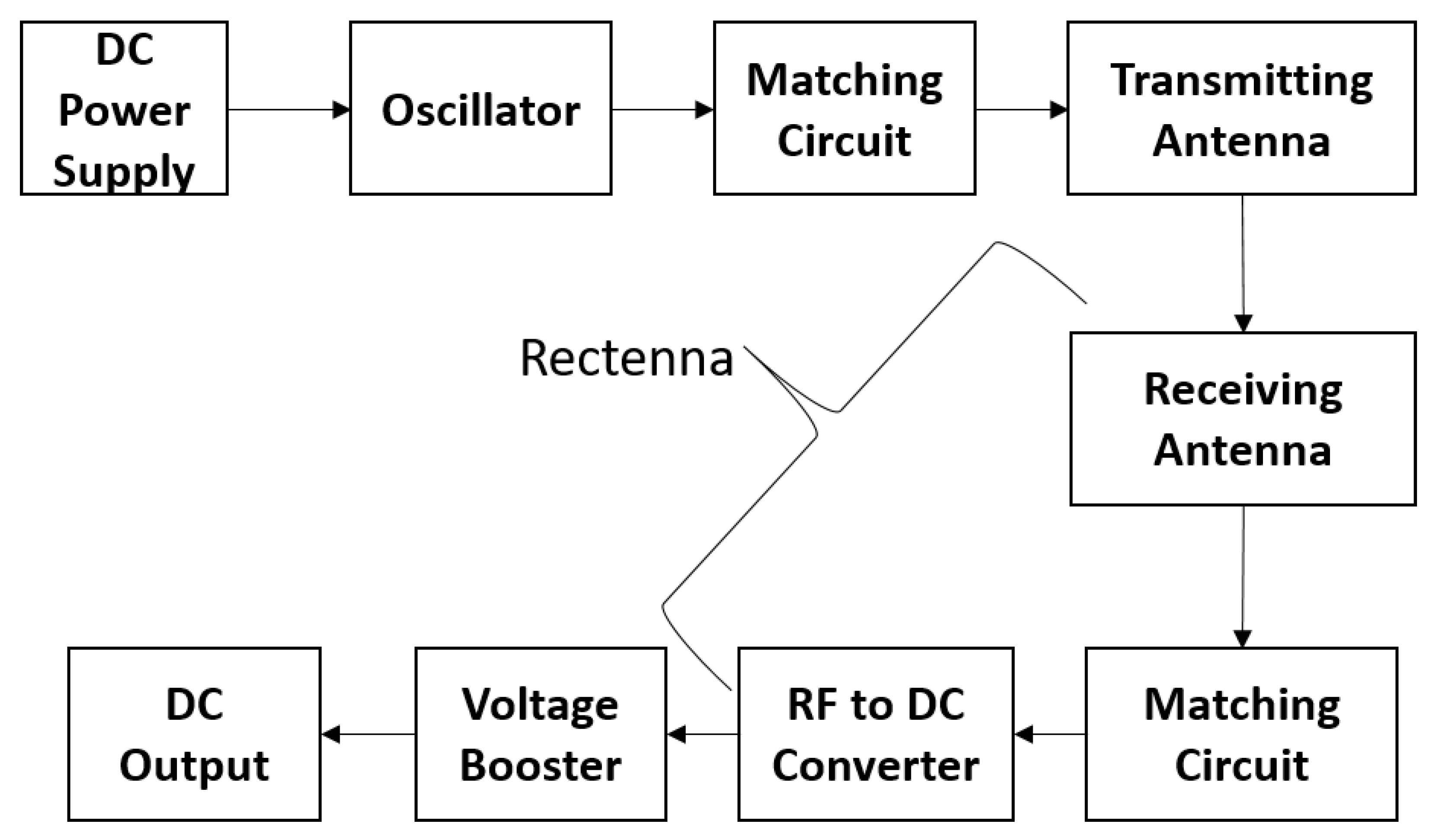
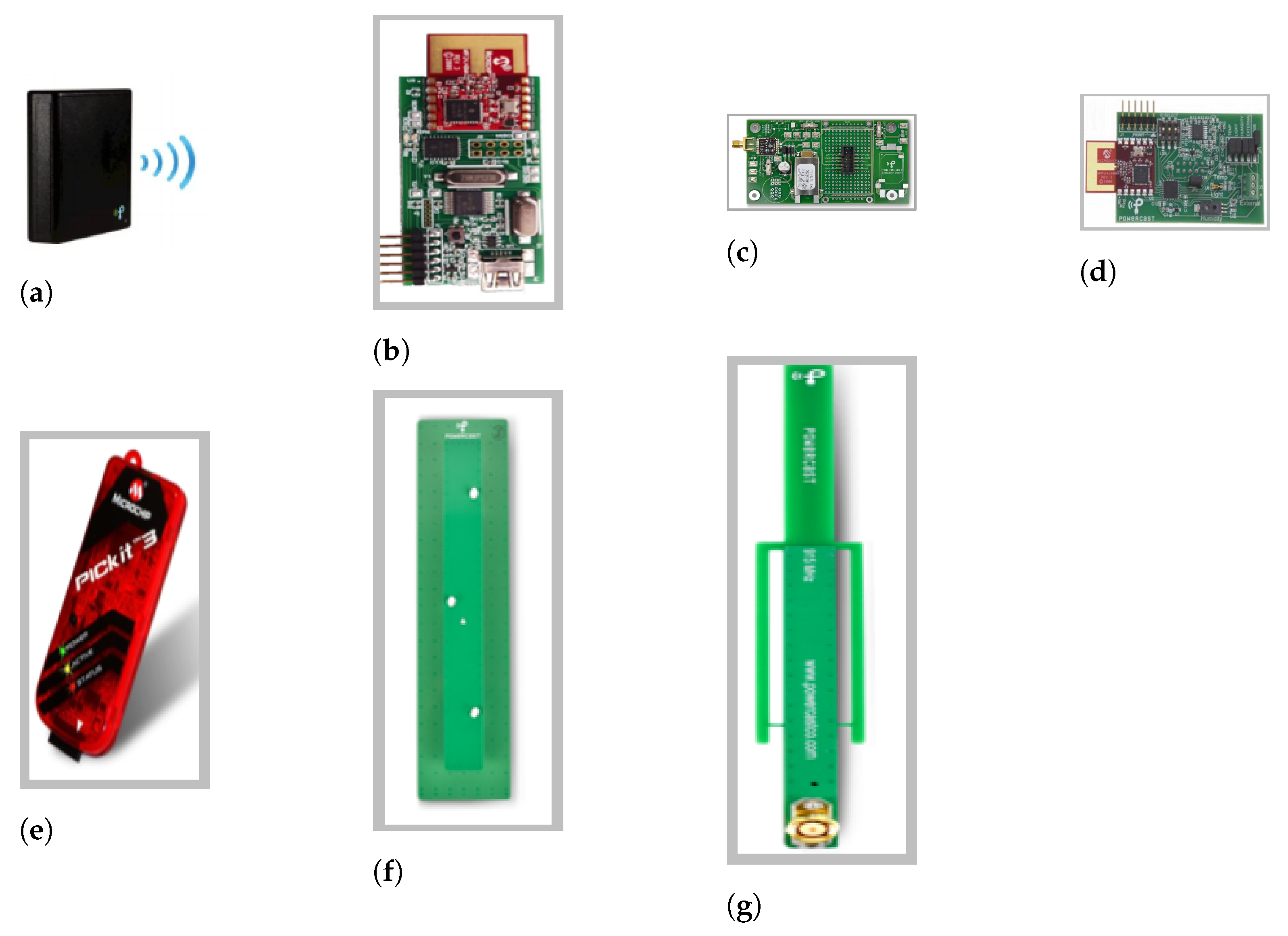



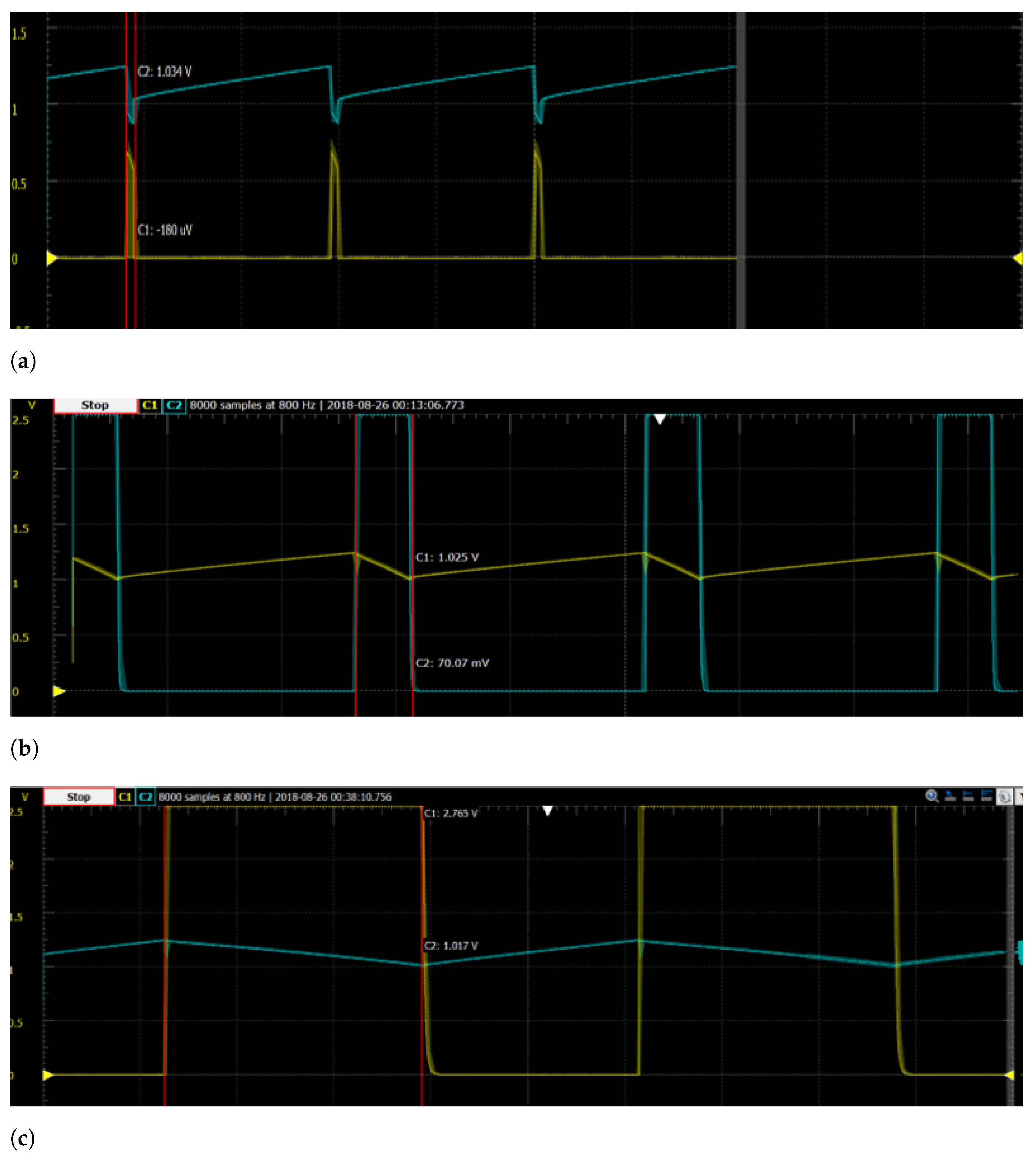
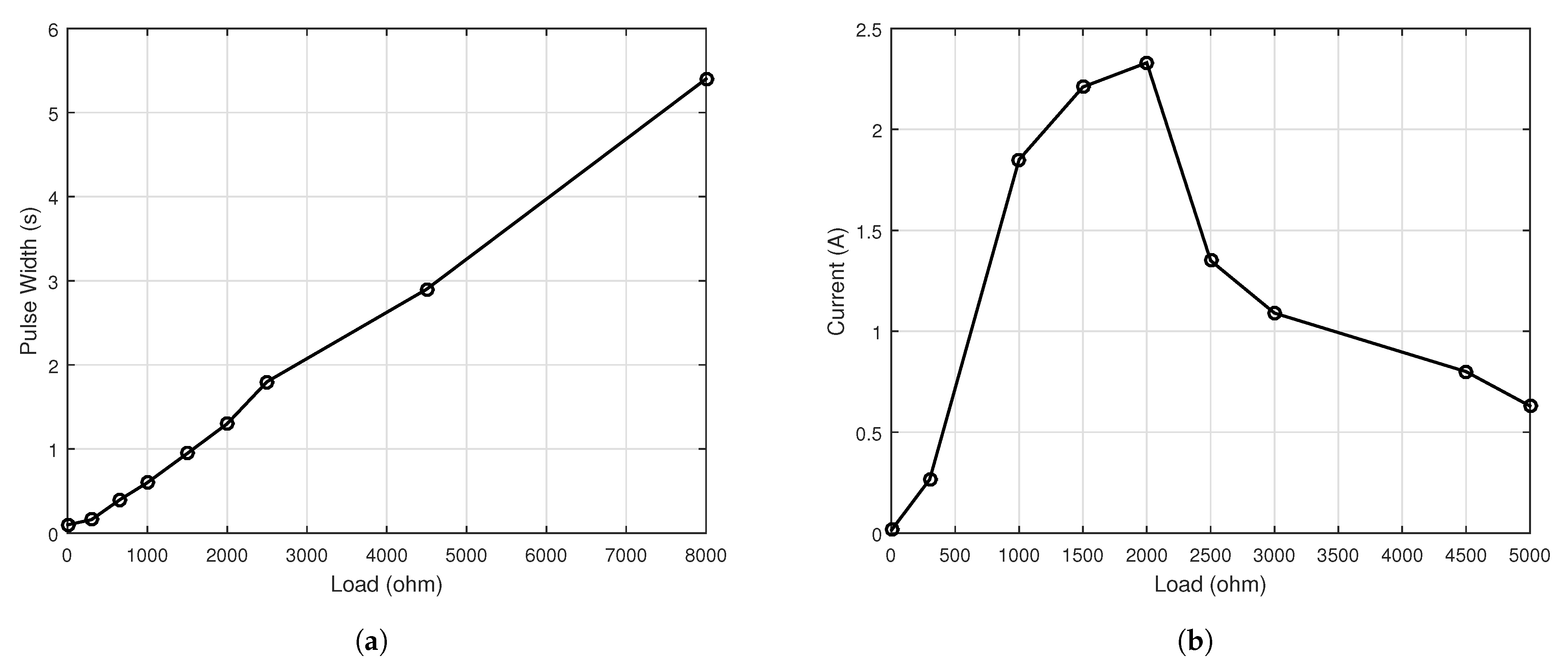

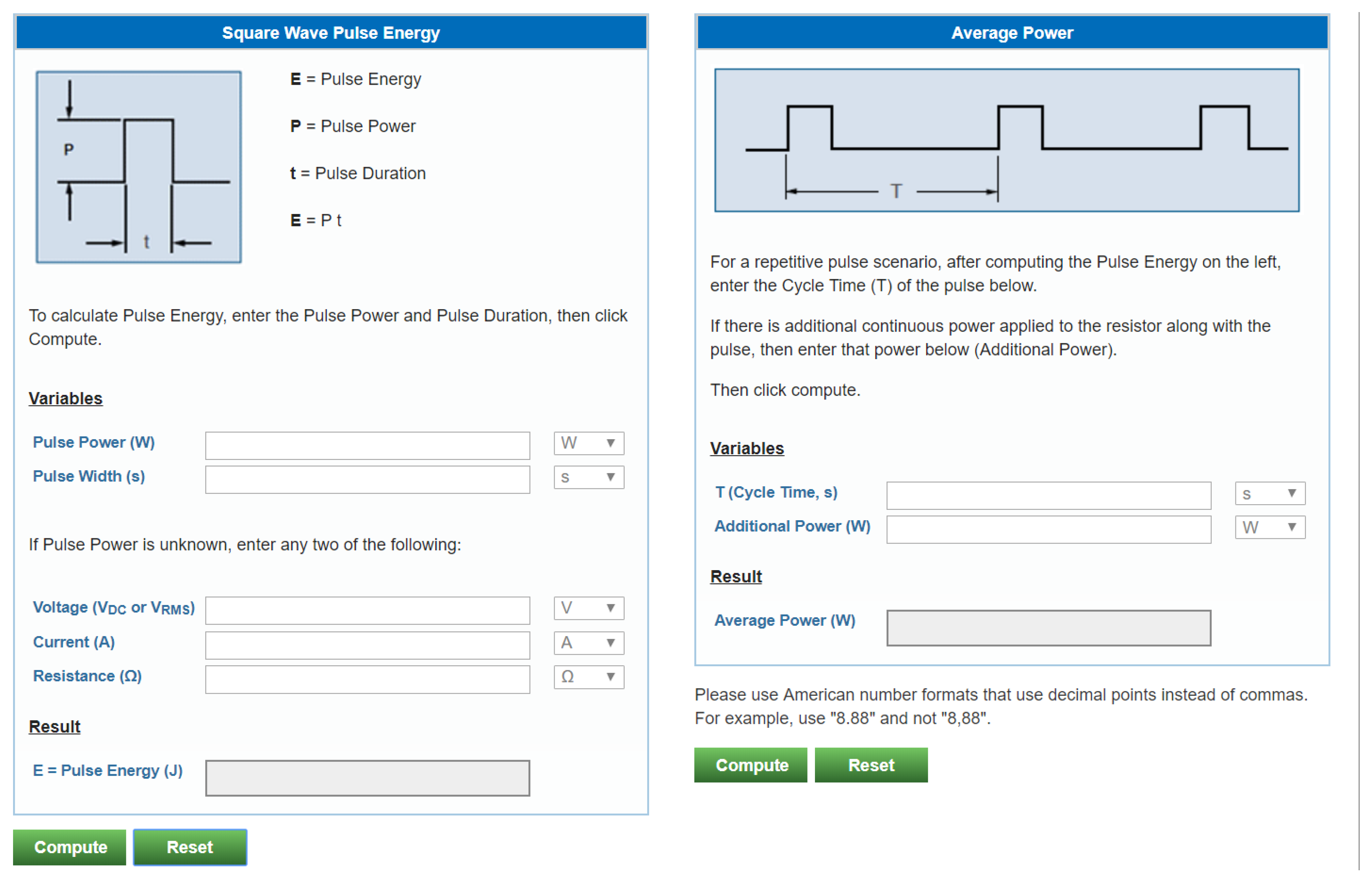

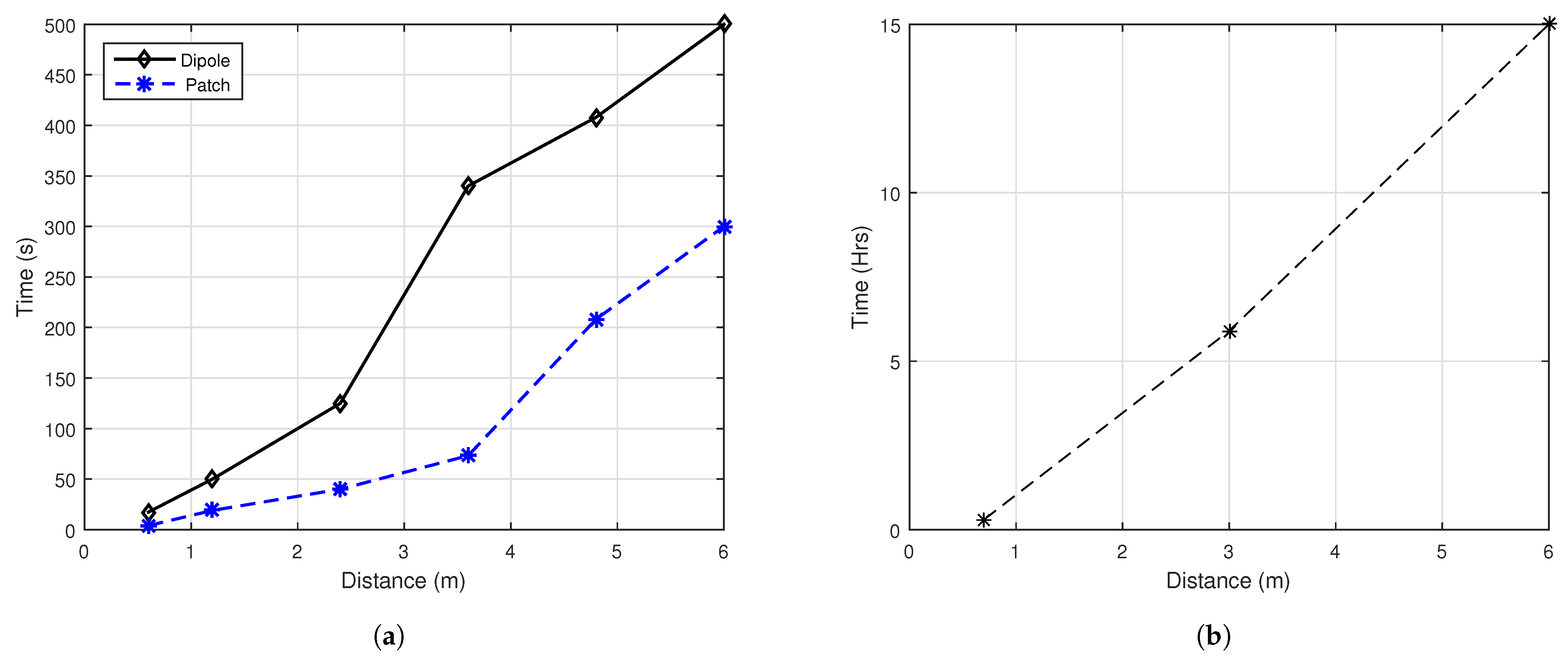

| Comparison | ||||||
|---|---|---|---|---|---|---|
| The Utilization for Off-the-Shelf WC Products | Approach | Cluster Head for WC | UGV as CH | Pros | Cons | |
| Peng, Y et al. [16] | No | Experimental | No | No | Tolerant to localization inaccuracy | Exponential complexity |
| Naderi, M.Y. et al. [19] | No | Experimental | No | No | Multi-frequency band RFenergy harvesting | Small size indoor WSN |
| Zungeru, A.M. et al. [20] | Yes | Experimental | No | No | Energy management | Lacks linking circuit for direct charging |
| Salim El, K et al. [23] | No | Simulation | Yes | No | Improved Life span and energy usage | Lacks of experimental study |
| Dai, H. et al. [25] | No | Theoretical and Simulation | No | No | Improved charging time | Lacks of experimental study |
| Meile, L. et al. [27] | Yes | Experimental | No | No | Small form factor antennas | Limited obstacles |
| Our work | Yes | Experimental and theoretical | Yes | Yes | Practical insight for WC technology adoption | Lacks of obstacles between the transmitter and receiver |
Publisher’s Note: MDPI stays neutral with regard to jurisdictional claims in published maps and institutional affiliations. |
© 2021 by the authors. Licensee MDPI, Basel, Switzerland. This article is an open access article distributed under the terms and conditions of the Creative Commons Attribution (CC BY) license (http://creativecommons.org/licenses/by/4.0/).
Share and Cite
Khalifeh, A.; Saadeh, M.; Darabkh, K.A.; Nagaradjane, P. Radio Frequency Based Wireless Charging for Unsupervised Clustered WSN: System Implementation and Experimental Evaluation. Energies 2021, 14, 1829. https://doi.org/10.3390/en14071829
Khalifeh A, Saadeh M, Darabkh KA, Nagaradjane P. Radio Frequency Based Wireless Charging for Unsupervised Clustered WSN: System Implementation and Experimental Evaluation. Energies. 2021; 14(7):1829. https://doi.org/10.3390/en14071829
Chicago/Turabian StyleKhalifeh, Ala’, Mai Saadeh, Khalid A. Darabkh, and Prabagarane Nagaradjane. 2021. "Radio Frequency Based Wireless Charging for Unsupervised Clustered WSN: System Implementation and Experimental Evaluation" Energies 14, no. 7: 1829. https://doi.org/10.3390/en14071829
APA StyleKhalifeh, A., Saadeh, M., Darabkh, K. A., & Nagaradjane, P. (2021). Radio Frequency Based Wireless Charging for Unsupervised Clustered WSN: System Implementation and Experimental Evaluation. Energies, 14(7), 1829. https://doi.org/10.3390/en14071829






